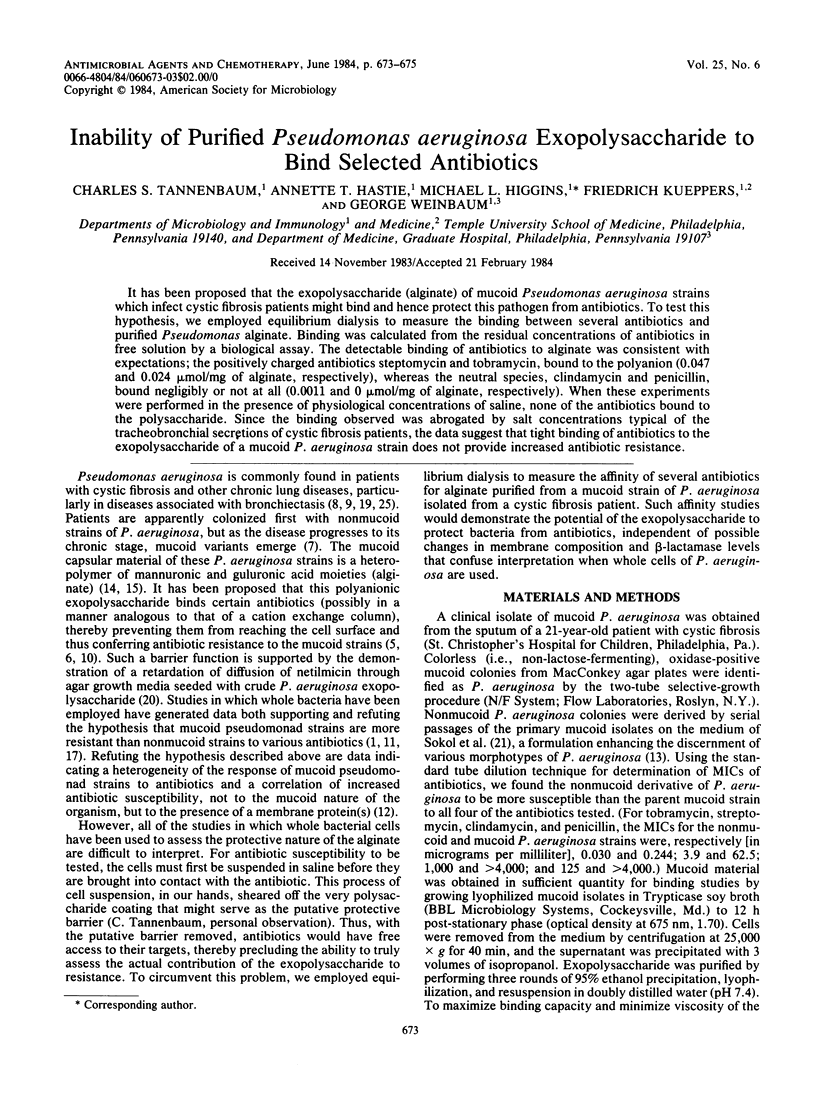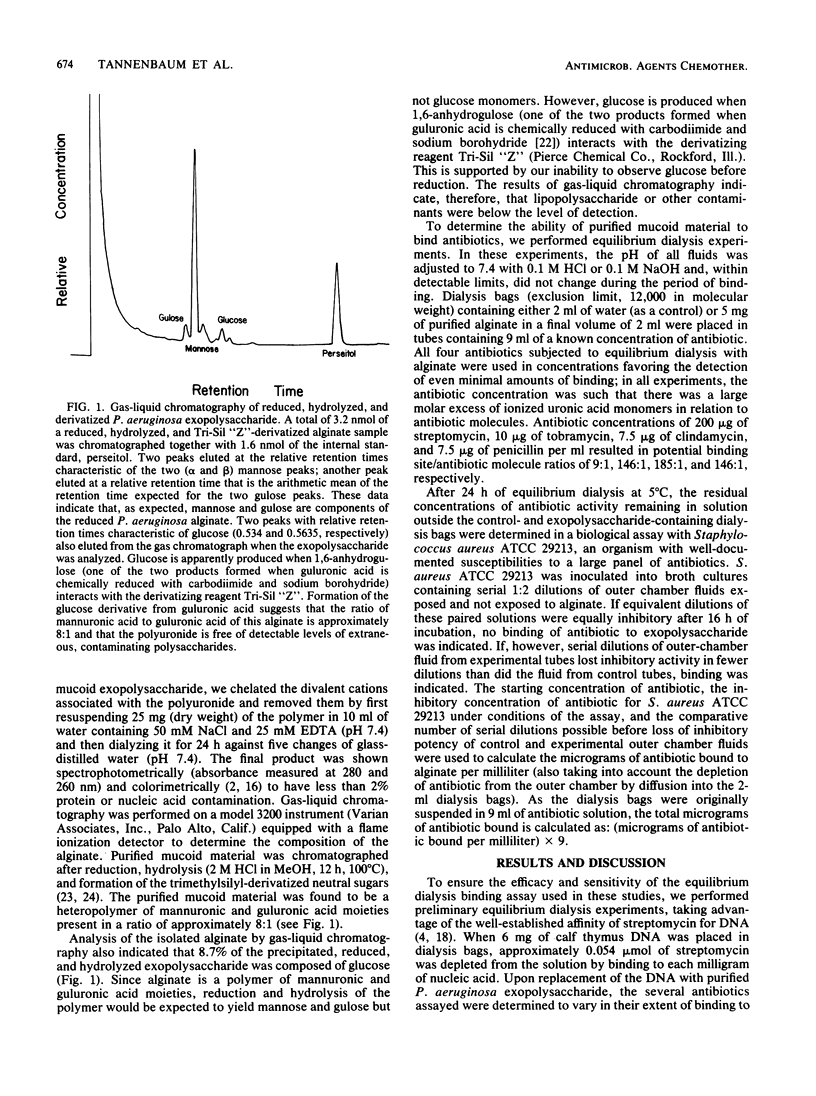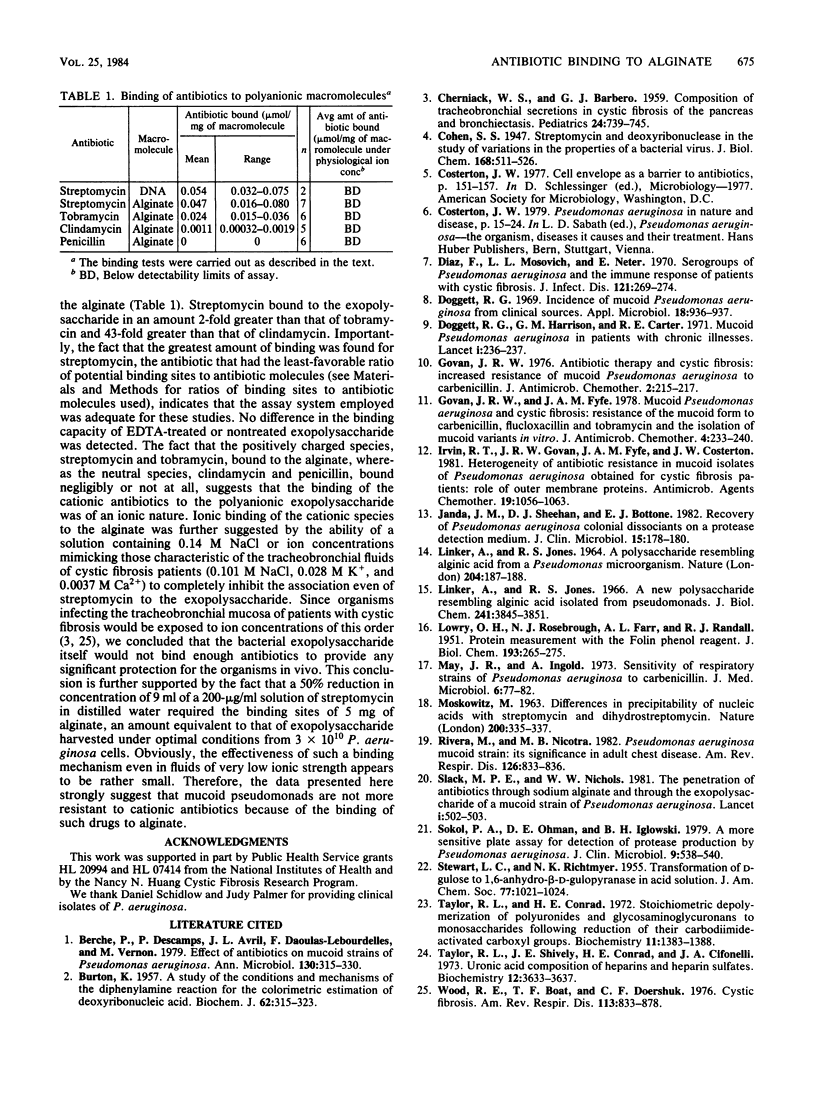Abstract
It has been proposed that the exopolysaccharide (alginate) of mucoid Pseudomonas aeruginosa strains which infect cystic fibrosis patients might bind and hence protect this pathogen from antibiotics. To test this hypothesis, we employed equilibrium dialysis to measure the binding between several antibiotics and purified Pseudomonas alginate. Binding was calculated from the residual concentrations of antibiotics in free solution by a biological assay. The detectable binding of antibiotics to alginate was consistent with expectations; the positively charged antibiotics steptomycin and tobramycin, bound to the polyanion (0.047 and 0.024 mumol/mg of alginate, respectively), whereas the neutral species, clindamycin and penicillin, bound negligibly or not at all (0.0011 and 0 mumol/mg of alginate, respectively). When these experiments were performed in the presence of physiological concentrations of saline, none of the antibiotics bound to the polysaccharide. Since the binding observed was abrogated by salt concentrations typical of the tracheobronchial secretions of cystic fibrosis patients, the data suggest that tight binding of antibiotics to the exopolysaccharide of a mucoid P. aeruginosa strain does not provide increased antibiotic resistance.
Full text
PDF


Selected References
These references are in PubMed. This may not be the complete list of references from this article.
- BURTON K. A study of the conditions and mechanism of the diphenylamine reaction for the colorimetric estimation of deoxyribonucleic acid. Biochem J. 1956 Feb;62(2):315–323. doi: 10.1042/bj0620315. [DOI] [PMC free article] [PubMed] [Google Scholar]
- Berche P., Descamps P., Avril J. L., Daoulas-Lebourdelles F., Véron M. Effect of antibiotics on mucoid strains of Pseudomonas aeruginosa. Ann Microbiol (Paris) 1979 Apr;130A(3):315–330. [PubMed] [Google Scholar]
- CHERNICK W. S., BARBERO G. J. Composition of tracheobronchial secretions in cystic fibrosis of the pancreas and bronchiectasis. Pediatrics. 1959 Nov;24:739–745. [PubMed] [Google Scholar]
- Diaz E., Mosovich L. L., Neter E. Serogroups of Pseudomonas aeruginosa and the immune response of patients with cystic fibrosis. J Infect Dis. 1970 Mar;121(3):269–274. doi: 10.1093/infdis/121.3.269. [DOI] [PubMed] [Google Scholar]
- Doggett R. G., Harrison G. M., Carter R. E. Mucoid Pseudomonas aeruginosa in patients with chronic illnesses. Lancet. 1971 Jan 30;1(7692):236–237. doi: 10.1016/s0140-6736(71)90973-1. [DOI] [PubMed] [Google Scholar]
- Doggett R. G. Incidence of mucoid Pseudomonas aeruginosa from clinical sources. Appl Microbiol. 1969 Nov;18(5):936–937. doi: 10.1128/am.18.5.936-937.1969. [DOI] [PMC free article] [PubMed] [Google Scholar]
- Govan J. R. Antibiotic therapy and cystic fibrosis: increased resistance of mucoid Pseudomonas aeruginosa to carbenicillin. J Antimicrob Chemother. 1976 Jun;2(2):215–217. doi: 10.1093/jac/2.2.215. [DOI] [PubMed] [Google Scholar]
- Govan J. R., Fyfe J. A. Mucoid Pseudomonas aeruginosa and cystic fibrosis: resistance of the mucoid from to carbenicillin, flucloxacillin and tobramycin and the isolation of mucoid variants in vitro. J Antimicrob Chemother. 1978 May;4(3):233–240. doi: 10.1093/jac/4.3.233. [DOI] [PubMed] [Google Scholar]
- Irvin R. T., Govan J. W., Fyfe J. A., Costerton J. W. Heterogeneity of antibiotic resistance in mucoid isolates of Pseudomonas aeruginosa obtained from cystic fibrosis patients: role of outer membrane proteins. Antimicrob Agents Chemother. 1981 Jun;19(6):1056–1063. doi: 10.1128/aac.19.6.1056. [DOI] [PMC free article] [PubMed] [Google Scholar]
- Janda J. M., Sheehan D. J., Bottone E. J. Recovery of Pseudomonas aeruginosa colonial dissociants on a protease detection medium. J Clin Microbiol. 1982 Jan;15(1):178–180. doi: 10.1128/jcm.15.1.178-180.1982. [DOI] [PMC free article] [PubMed] [Google Scholar]
- LINKER A., JONES R. S. A POLYSACCHARIDE RESEMBLING ALGINIC ACID FROM A PSEUDOMONAS MICRO-ORGANISM. Nature. 1964 Oct 10;204:187–188. doi: 10.1038/204187a0. [DOI] [PubMed] [Google Scholar]
- LOWRY O. H., ROSEBROUGH N. J., FARR A. L., RANDALL R. J. Protein measurement with the Folin phenol reagent. J Biol Chem. 1951 Nov;193(1):265–275. [PubMed] [Google Scholar]
- Linker A., Jones R. S. A new polysaccharide resembling alginic acid isolated from pseudomonads. J Biol Chem. 1966 Aug 25;241(16):3845–3851. [PubMed] [Google Scholar]
- MOSKOWITZ M. DIFFERENCES IN PRECIPITABILITY OF NUCLEIC ACIDS WITH STREPTOMYCIN AND DIHYDROSTREPTOMYCIN. Nature. 1963 Oct 26;200:335–337. doi: 10.1038/200335a0. [DOI] [PubMed] [Google Scholar]
- May J. R., Ingold A. Sensitivity of respiratory strains of Pseudomonas aeruginosa to carbenicillin. J Med Microbiol. 1973 Feb;6(1):77–82. doi: 10.1099/00222615-6-1-77. [DOI] [PubMed] [Google Scholar]
- Rivera M., Nicotra M. B. Pseudomonas aeruginosa mucoid strain. Its significance in adult chest diseases. Am Rev Respir Dis. 1982 Nov;126(5):833–836. doi: 10.1164/arrd.1982.126.5.833. [DOI] [PubMed] [Google Scholar]
- Slack M. P., Nichols W. W. The penetration of antibiotics through sodium alginate and through the exopolysaccharide of a mucoid strain of Pseudomonas aeruginosa. Lancet. 1981 Sep 5;2(8245):502–503. doi: 10.1016/s0140-6736(81)90885-0. [DOI] [PubMed] [Google Scholar]
- Sokol P. A., Ohman D. E., Iglewski B. H. A more sensitive plate assay for detection of protease production by Pseudomanas aeruginosa. J Clin Microbiol. 1979 Apr;9(4):538–540. doi: 10.1128/jcm.9.4.538-540.1979. [DOI] [PMC free article] [PubMed] [Google Scholar]
- Taylor R. L., Conrad H. E. Stoichiometric depolymerization of polyuronides and glycosaminoglycuronans to monosaccharides following reduction of their carbodiimide-activated carboxyl groups. Biochemistry. 1972 Apr 11;11(8):1383–1388. doi: 10.1021/bi00758a009. [DOI] [PubMed] [Google Scholar]
- Taylor R. L., Shively J. E., Conrad H. E., Cifonelli J. A. Uronic acid composition of heparins and heparan sulfates. Biochemistry. 1973 Sep 11;12(19):3633–3637. doi: 10.1021/bi00743a010. [DOI] [PubMed] [Google Scholar]
- Wood R. E., Boat T. F., Doershuk C. F. Cystic fibrosis. Am Rev Respir Dis. 1976 Jun;113(6):833–878. doi: 10.1164/arrd.1976.113.6.833. [DOI] [PubMed] [Google Scholar]


